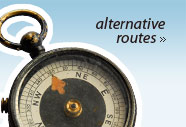Scandinavian Mountains over 2000 metres - James Baxter
Areas › Smørstabb Massif › 9.2 Smørstabbtind (2208m)
Store Smørstabbtind, 2208m, lies in the middle of the Smørstabb massif. It is the northern end of a spectacular arête that includes the subsidiary tops of Kniven, Geiti, Saksi, Veslebjørn, Kalven and the spectacular mountain of Storebjørn at the southern end. Each side of this lofty ridge are huge connected glaciers, which forms the largest continuous ice-sheet in Jotunheimen. At the northern end the of this arête the glaciers are Leirbreen on the west and the much researched Storbreen on the east.
| The Route from Krossbu Lodge | |
|---|---|
      |
|
From Krossbu drive over the small bridge to a car park on the south side of a shallow lake. Park here and follow the north bank of the river Leira for 2 km until you reach the triple waterfall the descends down from the south. Leave the path here and head north east for 2 km up to and beyond Veslefjell 1528. There is no need to reach the top of Veslefjell but just skirt round the south east flank until a small valley appears coming down from top 1730m. Cross this small valley and again skirt across the southern flank of top 1730m for 1 km while slowly ascending. Eventually you should reach a saddle between tops 1730m and 1723m. From here it is a ½ km over top 1723m and down to the outflow from the Leirvatnet lake at 1682m.
From Leirvatnet lake the final climb up the North-west ridge begins. The path is vague across the mixed grass and rock in the lower 1/4 until it gets to a very small tarn which is probably covered in a snowfield during the earlier part of summer.
After this tarn the vague path all but disappears and cairns appear erratically competing for attention. It is probably best to follow a line right up the middle of the ridge to the bottom of the buttress which looms above. This climb, up the second 1/4 of the ridge, is up steep, but stable, scree to the bottom of the buttress.
At the bottom of the buttress the scree gives way to a jumble of 45o degree slabs which are covered in loose scree. The various routes through these slabs are really quite easy, but on all there are a couple of areas where care is needed especially if others are below. This steeper area is shorter than it looks from below and it is not long before the top of the crags are reached.
From the top of the crags the final 1/4 to the summit is now visible up a much gentler and stable incline with a rapidly improving view. The summit itself offers a superb view over this remarkable alpine panorama of spires, sharp arêtes and heavily crevassed glaciers far below and further to the south the classic profile of Storebjørn
The descent is by the same route.

